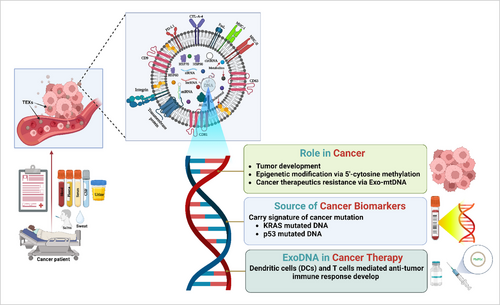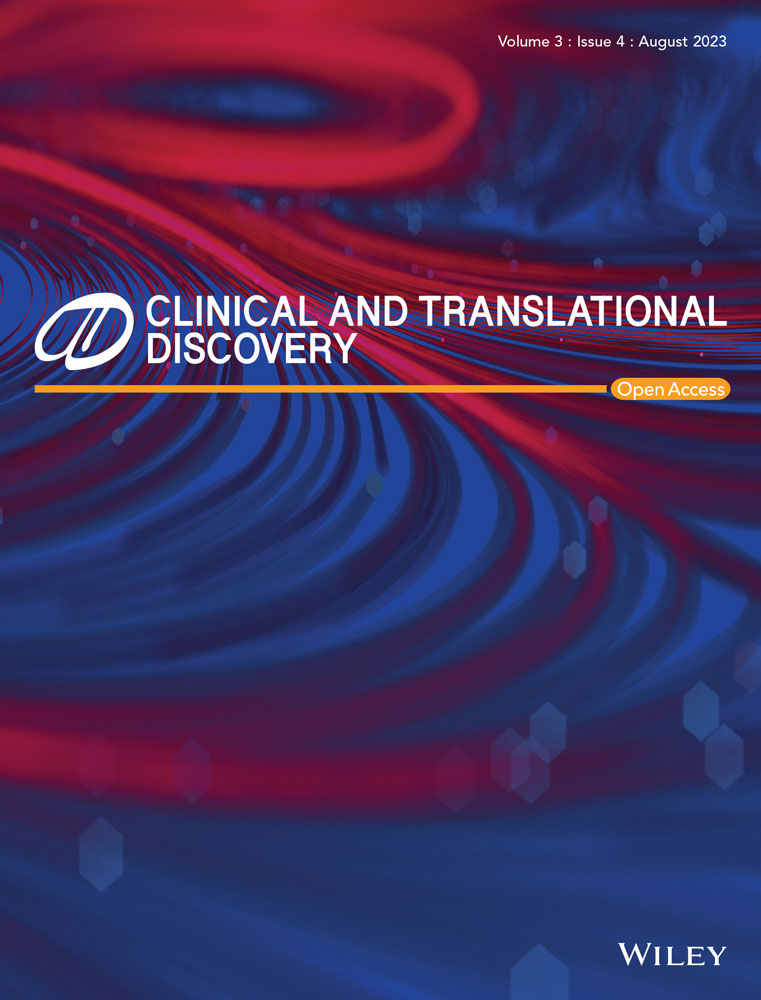Exosome DNA: An untold story of cancer
Rajib Dhar, Sayantanee Mukherjee, and Sukhamoy Gorai contributed equally to this study.
[Correction added on 04 December 2023; after first online publication missing sub-sections have been added.]
Abstract
Exosome is nanosized tiny membrane-bound vesicles and is a subpopulation of extracellular vesicles (EVs). In general, it participates in intercellular communication and acts as a messenger of several pathological complications. Exosome and cancer interlink is the most exciting domain of current cancer research. The internal molecular cargos (proteins, lipids, metabolites, miRNA, and DNA) of tumor derived exosomes (TEXs) are capable of transforming normal cells into tumor phenotypes. Exosome DNA is the less explored area of EVs research. It is involved in several events in cancer progression such as uncontrol cell growth, reprogramming of immune cells, metastasis, and therapeutic resistance. Exo-DNA is also involved in epigenetic alteration, which promotes cancer. It has a great impact on cancer theranostics (biomarker and therapeutics) research. Exo-DNA-based cancer examination supports more detailed cancer research.
Exosomes play a significant role in cell-to-cell communication. It originates from endosomes.1 It acts as a messenger of cellular conditions (it reflects the status of health or pathological complication). It plays an important role in cancer such as uncontrolled cell growth, immune suppression, angiogenesis, extracellular matrix remodeling, epithelial-mesenchymal transition, and metastasis.2 In the advanced cancer stage, tumor cells develop mortality and enter in a circulating system, in which phage tumor cells are controlled by tumor cells derived exosomes (TEXs) (TEXs integrin play a vital role in this event) and led organ-specific metastasis.2, 3 In 2014, Kahlert et al. identify exosome DNA in a pancreatic cancer serum sample with a mutational signature (containing mutated KRAS and p53 DNA).4 In general, exosomes carry multiple molecular cargoes such as DNA, RNA, proteins, and lipids.1 Among the several cargos of exosome, cargo DNA (100 to 10 Kb) plays an important role in cancer development.5 TEXs carry a larger amount of double-stranded DNA (dsDNA) and incorporate 5′-cytosine methylation,6, 7 which is associated with epigenetic modification in cancer. This epigenetic alteration promotes the development of cancer.8 Research evidence suggests that exosome DNA carries a mutational signature of the parental cell.9, 4 In general, cytosolic DNA develops in the context of genetic instability and promotes metastasis.10 Scientific evidence also suggests that exosome–mediated mitochondrial-DNA (mtDNA) transport is related to the development of drug resistance.11, 12 In cancer, the patients’ death is caused by asymptomatic cancer development. This phenomenon is called cancer dormancy (this process of the tumor maintaining the balance between cell growth and cell death).13 Exosomes miRNA maintains dormancy in metastatic cancer.14 An exciting fact is that cancer-associated fibroblasts derive mtDNA to escape cancer dormancy and develop therapeutic resistance.15 There are numerous publications worldwide indicating that the exosome is a promising biomarker based on proteins and miRNAs. Exosomal DNA is a less exposure domain compared to the exo-miRNA field. Recent research suggests that cell-free exo-DNA is a potential marker for cancer detection.16, 17 Exo-DNA is an ideal biomaterial for liquid biopsy due to its molecular stability compared to Exo-miRNA.17 Exo-DNA-based liquid biopsy tests are developed as more effective diagnostic tools in the future. Exo–DNA has a potential role in the cancer healing process. Research evidence shows that anti-cancer drugs treated cancer cells released Exo–DNA responsible for dendritic cell (DCs)-mediated anti-tumor immune response via STRING pathways.18 In cancer, CD8+ (Cytotoxic T cell) cells are the vital cell population that develops an anti-tumor immune response. A research group reported that radiotherapy exposes mice (they carry breast cancer) to derive TEXs that transport dsDNA to DCs and enhance the CD8+ cells mediated anti-tumor response.19 In cancer, ExoDNA associations and their theranostics impact are summarized in Figure 1. Exo-DNA-based theranostics approaches required some clarity such as function diversity ss-Exo–DNA and ds-Exo–DNA, Exo–DNA packaging, and releasing mechanism, different stages of cancer Exo-DNA nature changing and Exo-DNA impact in cancer hallmarks, all these quarries are still under the question mark. The world of EVs research also becomes complex due to the exosome heterogeneity (exosome size, origin, and molecular diversity control it), single exosome profiling solved this complication.20 The exosome-based understanding of cancer supports us in getting closer to precision oncology.21 The major intention of this article underlines the importance of exosome DNA in cancer research and could become a therapeutic target with effective outcomes in cancer treatment in the future.

AUTHOR CONTRIBUTIONS
Substantial contributions to the conception or design of the work or the acquisition, analysis, or interpretation of the data for the work: Bikramjit Bhattacharya, Rajib Dhar, Sayantanee Mukherjee, Sukhamoy Gorai. Drafting the work or revising it critically for important intellectual content: Bikramjit Bhattacharya, Rajib Dhar, Sayantanee Mukherjee, Sukhamoy Gorai, Arikketh Devi, Anand Krishnan, Athanasios Alexiou, Marios Papadakis. Final approval of the version to be published: Bikramjit Bhattacharya, Rajib Dhar, Sayantanee Mukherjee, Sukhamoy Gorai, Arikketh Devi, Anand Krishnan, Athanasios Alexiou, Marios Papadakis.
ACKNOWLEDGEMENTS
Not applicable.
CONFLICT OF INTEREST STATEMENT
The authors declare that they have no competing interests.
FUNDING INFORMATION
The authors received no specific funding for this work.
ETHICS APPROVAL AND CONSENT TO PARTICIPATE
There are no human or animal studies in this paper.
Open Research
DATA AVAILABILITY STATEMENT
Data sharing is not applicable to this article as no datasets were generated or analysed during the current study.




